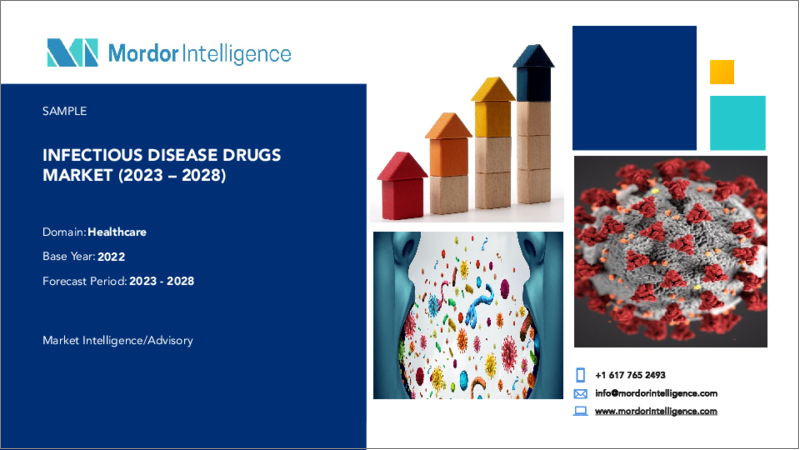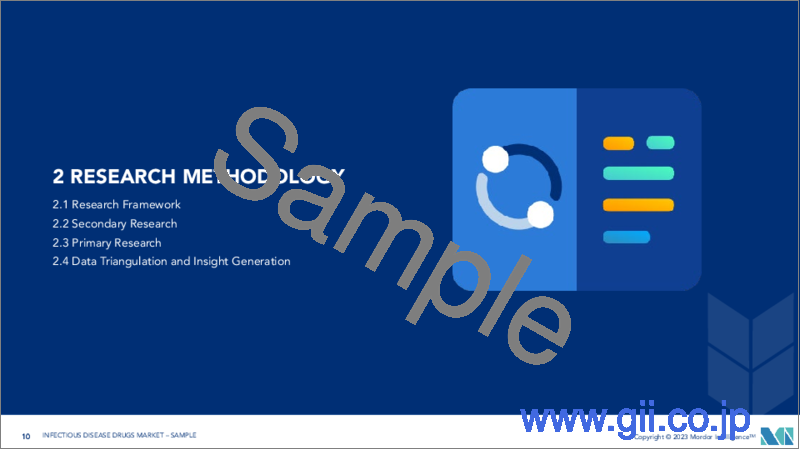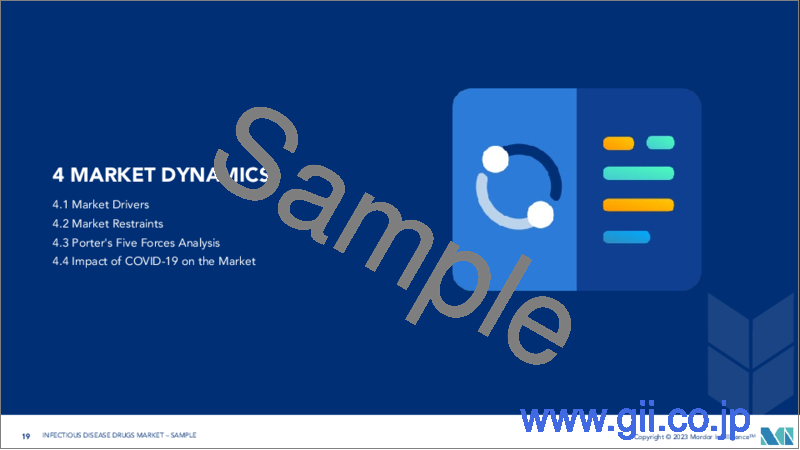|
|
市場調査レポート
商品コード
1197280
感染症治療薬市場- 成長、動向、予測(2023年~2028年)Infectious Disease Drugs Market - Growth, Trends, and Forecasts (2023 - 2028) |
||||||
|
● お客様のご希望に応じて、既存データの加工や未掲載情報(例:国別セグメント)の追加などの対応が可能です。 詳細はお問い合わせください。 |
|||||||
| 感染症治療薬市場- 成長、動向、予測(2023年~2028年) |
|
出版日: 2023年01月23日
発行: Mordor Intelligence
ページ情報: 英文 120 Pages
納期: 2~3営業日
|
- 全表示
- 概要
- 目次
感染症治療薬市場は、予測期間(2023年~2028年)にCAGR4.3%を記録すると予想されています。
COVID-19の発生は、市場に大きな影響を及ぼしています。雇用の閉鎖により輸出入活動が抑制されたため、市場にかなりの影響を及ぼし、ヘルスケア施設全体で感染症治療薬や消耗品の不足と入手不能が発生しています。生産設備の一時停止、輸出規制、COVID-19の需要増、物資の供給停止、サービスの中断などにより、感染症発生当初の市場に与えた影響は甚大でした。さらに、数カ国でほとんどの新コースの開始を延期する企業が増え、同薬の臨床試験も縮小しました。さらに、COVID-19の流行により、感染症患者の外来診療が減少し、これも市場全体の成長に大きな影響を与えています。例えば、2021年に国立生物工学情報センターが発表した記事「The impact of COVID-19 on hepatitis services and civil society organizations」によると、COVID-19の流行が世界的に肝炎の予防、検査、治療、予防接種サービスに影響を与えたと述べられています。同様に、世界保健機関(WHO)が発表したデータによると、2020年、ほとんどのマラリア蔓延国は、抗寄生虫サービスの提供において中程度の混乱に直面しました。しかし、サービスや手続きの再開、COVID-19からの市場の回復により、感染症薬市場は予測期間中にそのポテンシャルを完全に取り戻すと予想されます。
感染症治療薬市場の成長の主な要因は、様々な政府機関や非営利団体による啓発活動の活発化、感染症の流行、資金調達の増加や研究開発活動の活発化などです。例えば、世界保健機関が発表した「Global Tuberculosis Report 2021」のデータによると、結核患者の多くは、東南アジア(43%)、アフリカ(25%)、西太平洋(18%)の世界保健機関(WHO)地域で見られ、東地中海(8.3%)、アメリカ(3.0%)、欧州(2.3%)では結核患者は少なかったとされています。同様に、2021年に発表された世界保健機関(WHO)のデータによると、サハラ以南のアフリカはマラリアの負担に耐え続け、全患者の約95%、全死亡者の96%を占めているようです。このように、感染症患者数の増加により、感染症治療薬の需要が高まり、市場が高成長することが予想されます。
しかし、新興国における診断・治療の普及率の低さや薬剤の副作用が市場成長の妨げになる可能性があります。
感染症治療薬の市場動向
予測期間中、マラリア疾患セグメントが大きな市場シェアを占める見込み
インド、アフリカ、その他の東南アジア諸国などの新興国や低開発国におけるマラリア疾患の有病率の上昇、医療機関だけでなく市場関係者による研究開発活動の活発化により、マラリア疾患領域は予測期間中に成長すると予想されます。
マラリア病の流行増加は、予測期間中に感染症治療薬の需要を促進する重要な要因となっています。例えば、2021年に発表された世界保健機関(WHO)のデータによると、サハラ以南のアフリカは、おそらくマラリアの負担に耐え続け、全患者の約95%、全死亡者の96%を占めています。さらに、2021年にWHOが発表したレポート「World Malaria Report」によると、2020年には85のマラリア常在国のうち29カ国が全マラリア患者の96%を占めています。インドは、世界のマラリア患者の約1.7%、死亡者の約1.2%を占めています。同出典によると、2019年のマラリア症例が2億2,700万件だったのに対し、2020年は2億4,100万件と推定されています。このように、各国でのマラリア患者数の増加は、マラリア治療薬の需要を高め、それがさらに感染症に対する需要を高め、市場の成長を高めると考えられます。
また、研究開発活動の高まりや、製品パイプラインの開発のための企業間提携の増加が、予測期間中のマラリア治療薬市場に有益な機会を提供しています。例えば、2021年4月、ヤンセン・ファーマスーティカNVは、オーストラリアの医療研究センターであるウォルター・アンド・エリザ・ホール医学研究所(WEHI)と、潜在的な新規抗マラリア薬候補の開発のために共同研究を実施しました。この共同研究チームは、Janssen Jump-stARter Compound Libraryに含まれる8万個の薬剤様分子の中から、抗マラリア活性を有する化合物を発見しました。現在、最も有望な候補化合物は、研究者によって抗マラリア薬候補としてさらに開発が進められています。
このように、さまざまな国でマラリア病の負担が増加していることや研究開発活動が活発化していることから、感染症治療薬の需要が高まり、市場の成長が促進されるものと思われます。
予測期間中、北米が最大の市場シェアを占めると予想される
北米は、感染症の流行が拡大していること、より良いヘルスケアインフラの存在、主要な市場プレイヤーの存在、啓発プログラムの増加などにより、感染症治療薬市場において主要な市場シェアを占めると予想されます。
感染症の流行は、同地域の市場成長を促進する重要な要因となっています。例えば、世界保健機関によると、2021年にアメリカで報告されたマラリアの症例は72万3,000件を超え、2010年と比較して7%増加しています。同様に、MedAlertHelpが発表した統計によると、2022年には、アメリカ人の約5%から20%が毎年インフルエンザと診断されています。さらに、米国疾病対策予防センターが発表したデータによると、2021年10月、2019-2020年シーズンにおいて、全体で3500万人のインフルエンザ関連疾患、38万人のインフルエンザ関連入院、2万人のインフルエンザ関連死亡、1600万人のインフルエンザ関連診察が報告されたとのことです。
また、企業や団体が感染症治療薬の開発に注力するようになり、同地域での製品上市が増加していることが、米国での市場成長を後押しすると予想されます。例えば、2021年9月、非営利団体であるTBアライアンスは、ルパンに抗結核薬プレトマニドの製造に関する非独占的ライセンスを付与しました。同様に、2021年3月、ギリアドは1450億ユーロでMyr Pharmaceuticalsを買収しました。この買収により、ギリアドは、2020年7月に欧州医薬品庁から代償性肝疾患を有する成人の慢性肝炎δウイルス(HDV)の治療薬として条件付きで承認されたHepcludex(blevirtide)にアクセスすることができるようになりました。
このように、上記のような要因から、市場は予測期間中に高い成長を遂げると予想されます。
感染症治療薬市場の競合他社分析
本市場は、様々なプレイヤーが存在するため、断片的な市場となっています。市場プレイヤーの中には、AbbVie Inc、Gilead Sciences, Inc、GlaxoSmithKline plc、Merck &Co, Inc、F Hoffmann-La Roche, Ltd、Boehringer Ingelheim GmbH、Janssen Pharmaceutical(Johnson &Johnson)およびNovartis AGが含まれます。
その他の特典
- エクセル形式の市場予測(ME)シート
- 3ヶ月間のアナリストサポート
目次
第1章 イントロダクション
- 調査の前提条件と市場の定義
- 調査対象範囲
第2章 調査手法
第3章 エグゼクティブサマリー
第4章 市場力学
- 市場概要
- 市場促進要因
- 様々な政府機関や非営利団体による啓発活動の活発化
- 感染症の増加
- 研究開発の活発化と資金調達の増加
- 市場抑制要因
- 新興諸国における診断・治療の普及率の低さ
- 薬剤の副作用
- ポーターのファイブフォース分析
- 新規参入業者の脅威
- 買い手/消費者の交渉力
- 供給企業の交渉力
- 代替品の脅威
- 競争企業間の敵対関係
第5章 市場セグメンテーション(金額ベース市場規模- 百万米ドル)
- 疾患別
- HIV
- インフルエンザ
- 肝炎
- 結核
- マラリア
- その他
- 治療法別
- 抗菌剤
- 抗ウイルス剤
- 抗寄生虫剤
- その他
- 地域別
- 北米
- 米国
- カナダ
- メキシコ
- 欧州
- ドイツ
- 英国
- フランス
- イタリア
- スペイン
- その他の欧州地域
- アジア太平洋地域
- 中国
- 日本
- インド
- オーストラリア
- 韓国
- その他アジア太平洋地域
- 中東地域
- GCC
- 南アフリカ
- その他の中東地域
- 南米
- ブラジル
- アルゼンチン
- その他の南米地域
- 北米
第6章 競合情勢
- 企業プロファイル
- AbbVie Inc.
- Boehringer Ingelheim GmbH
- Gilead Sciences, Inc.
- GlaxoSmithKline plc
- Janssen Pharmaceutical(Johnson & Johnson)
- Merck & Co., Inc.
- Novartis AG
- F Hoffmann-La Roche, Ltd
- Sanofi SA
- Takeda Pharmaceutical Company Limited
- Hookipa Pharma Inc.
- Bajaj Healthcare Limited
第7章 市場機会と今後の動向
The infectious disease drugs market is expected to register a CAGR of 4.3% during the forecast period (2023 - 2028).
The COVID-19 outbreak has had a significant impact on the market. As employment closures have curtailed import and export activities, there has been a considerable influence on the market, resulting in shortages and unavailability of infectious drugs and supplies across healthcare facilities. Due to the temporary shutdown of production facilities, export restrictions, increased demand for the COVID-19 medication, disruptions in the supply of goods, and interruptions in services, the impact of the outbreak in its initial phase on the infectious drugs market was substantial. Additionally, clinical trials of the drug have been reduced as more and more companies delay the start of most new courses in several countries. In addition, the COVID-19 epidemic has seen a decline in outpatient services for patients with infectious diseases, which has also had a significant impact on overall market growth. For instance, according to an article published by the National Center for biotechnology information, in 2021, titled " The impact of COVID-19 on hepatitis services and civil society organizations", stated that the COVID-19 pandemic has affected hepatitis prevention, testing, treatment, and vaccination services globally. Similarly, as per the data published by the World Health Organization (WHO), in 2020, most malaria-endemic countries faced moderate disruptions in anti-parasitic service delivery. However, with the resumed services and procedures and the market recovering from the COVID-19, the infectious disease drugs market is expected to regain its full potential over the forecast period.
The major factors for the growth of the infectious disease drugs market are the rising awareness activities by various government and non-profit organizations, the increasing prevalence of infectious diseases, and the rising funding and increasing research and development activities. For instance, according to the data published by the World Health Organization in the Global Tuberculosis Report 2021, most of the tuberculosis cases were found in the World Health Organization (WHO) regions of South-East Asia (43%), Africa (25%) and the Western Pacific (18%), and lesser numbers of tuberculosis cases were found in Eastern Mediterranean (8.3%), the Americas (3.0%) and Europe (2.3%). Similarly, according to the World Health Organization (WHO) data published in 2021, Sub-Saharan Africa likely continues to endure the burden of malaria, accounting for approximately 95% of all cases and 96% of all deaths. Thus, rising cases of infectious diseases are expected to increase the demand for infectious drugs resulting in the high growth of the market.
However, the low penetration rates of diagnosis and treatment in developing countries and the side effects of the drugs are likely to hinder the growth of the market.
Infectious Disease Drugs Market Trends
Malaria Segment is Expected to Hold a Significant Market Share over the Forecast Period
The malaria disease segment is expected to grow over the forecast period owing to the increasing prevalence of malaria disease in developing and under-developed countries such as India, Africa, and other Southeast Asian countries, rising research and development activities by the market players as well as the health care organizations.
The rising prevalence of malaria diseases is the key factor driving the demand for infectious disease drugs over the forecast period. For instance, according to the World Health Organization (WHO) data published in 2021, Sub-Saharan Africa likely continues to endure the burden of malaria, accounting for approximately 95% of all cases and 96% of all deaths. Furthermore, as per the report "World Malaria Report" published by WHO in 2021, 29 of the 85 malaria-endemic countries accounted for 96% of all malaria cases in 2020. India contributed approximately 1.7% of malaria cases and 1.2% of deaths globally. As per the same source, there were an estimated 241 million malaria cases in 2020, as compared to 227 million cases in 2019. Thus, the increasing number of malaria cases across countries is likely to increase the demand for malarial drugs, which further increases the demand for infectious diseases, thereby increasing the market growth.
In addition, the rising research and development activities and an increasing number of company collaborations for the development of product pipelines are providing beneficial opportunities for the malarial drugs market over the forecast period. For instance, in April 2021, Janssen Pharmaceutica NV collaborated with Walter and Eliza Hall Institute of Medical Research (WEHI), an Australian Medical Research Center, to develop potential new antimalarial drug candidates. The collaborative research team discovered compounds with antimalarial activity within a collection of 80,000 drug-like molecules in the Janssen Jump-stARter Compound Library. The most promising candidates are now being further developed by the researchers towards potential antimalarial drugs.
Thus, the increasing burden of malaria disease in various countries and increasing research and development activities are likely to increase the demand for infectious disease drugs, thereby boosting the market growth.
North America is Expected to Hold Largest Market Share over the Forecast Period
North America is expected to hold a major market share in the infectious diseases drugs market owing to the rising prevalence of infectious diseases and the presence of better healthcare infrastructure, the presence of key market players, and increasing awareness programs.
The rising prevalence of infectious diseases is the key factor driving the growth of the market in the region. For instance, according to the World Health Organization, in 2021, more than 723,000 cases of malaria were reported in America in 2019, an increase of 7% as compared to 2010. Similarly, according to statistics published by MedAlertHelp, in 2022, about 5% to 20% of Americans are diagnosed with influenza every year. Further, according to the data published by the Centers for Disease Control and Prevention, in October 2021, overall, 35 million flu-related illnesses, 380,000 flu-related hospitalizations, 20,000 flu-related deaths, and 16 million flu-related medical visits were reported in the 2019-2020 season.
In addition, the increasing focus of companies and organizations on developing drugs for treating infectious diseases and rising product launches in the region is expected to boost the market growth in the United States. For instance, in September 2021, TB Alliance, a non-profit organization, granted a non-exclusive license to Lupin to manufacture the anti-TB drug pretomanid. Similarly, in March 2021, Gilead acquired Myr Pharmaceuticals for EUR 145 billion. This acquisition provides Gilead access to Hepcludex (bulevirtide), which was conditionally approved by the European Medicines Agency for the treatment of chronic hepatitis delta virus (HDV) in adults with compensated liver disease in July 2020.
Thus, owing to all the above-mentioned factors, the market is expected to witness high growth over the forecast period.
Infectious Disease Drugs Market Competitor Analysis
The market studied is a fragmented market owing to the presence of various market players. Some of the market players are AbbVie Inc, Gilead Sciences, Inc., GlaxoSmithKline plc, Merck & Co., Inc., F Hoffmann-La Roche, Ltd, Boehringer Ingelheim GmbH, Janssen Pharmaceutical (Johnson & Johnson) and Novartis AG.
Additional Benefits:
- The market estimate (ME) sheet in Excel format
- 3 months of analyst support
TABLE OF CONTENTS
1 INTRODUCTION
- 1.1 Study Assumptions and Market Definition
- 1.2 Scope of the Study
2 RESEARCH METHODOLOGY
3 EXECUTIVE SUMMARY
4 MARKET DYNAMICS
- 4.1 Market Overview
- 4.2 Market Drivers
- 4.2.1 Rising Awareness Activities by Various Government and Non-profit Organizations
- 4.2.2 Increasing Prevalence of Infectious Diseases
- 4.2.3 Rising Funding and Increasing Research and Development Activities
- 4.3 Market Restraints
- 4.3.1 Low Penetration Rates of Diagnosis and Treatment in Developing Countries
- 4.3.2 Side Effects of the Drugs
- 4.4 Porter's Five Forces Analysis
- 4.4.1 Threat of New Entrants
- 4.4.2 Bargaining Power of Buyers/Consumers
- 4.4.3 Bargaining Power of Suppliers
- 4.4.4 Threat of Substitute Products
- 4.4.5 Intensity of Competitive Rivalry
5 MARKET SEGMENTATION (Market Size by Value - USD million)
- 5.1 By Disease
- 5.1.1 HIV
- 5.1.2 Influenza
- 5.1.3 Hepatitis
- 5.1.4 Tuberculosis
- 5.1.5 Malaria
- 5.1.6 Other
- 5.2 By Treatment
- 5.2.1 Antibacterial
- 5.2.2 Antiviral
- 5.2.3 Antiparasitic
- 5.2.4 Other
- 5.3 Geography
- 5.3.1 North America
- 5.3.1.1 United States
- 5.3.1.2 Canada
- 5.3.1.3 Mexico
- 5.3.2 Europe
- 5.3.2.1 Germany
- 5.3.2.2 United Kingdom
- 5.3.2.3 France
- 5.3.2.4 Italy
- 5.3.2.5 Spain
- 5.3.2.6 Rest of Europe
- 5.3.3 Asia-Pacific
- 5.3.3.1 China
- 5.3.3.2 Japan
- 5.3.3.3 India
- 5.3.3.4 Australia
- 5.3.3.5 South Korea
- 5.3.3.6 Rest of Asia-Pacific
- 5.3.4 Middle-East
- 5.3.4.1 GCC
- 5.3.4.2 South Africa
- 5.3.4.3 Rest of Middle-East
- 5.3.5 South America
- 5.3.5.1 Brazil
- 5.3.5.2 Argentina
- 5.3.5.3 Rest of South America
- 5.3.1 North America
6 COMPETITIVE LANDSCAPE
- 6.1 Company Profiles
- 6.1.1 AbbVie Inc.
- 6.1.2 Boehringer Ingelheim GmbH
- 6.1.3 Gilead Sciences, Inc.
- 6.1.4 GlaxoSmithKline plc
- 6.1.5 Janssen Pharmaceutical (Johnson & Johnson)
- 6.1.6 Merck & Co., Inc.
- 6.1.7 Novartis AG
- 6.1.8 F Hoffmann-La Roche, Ltd
- 6.1.9 Sanofi SA
- 6.1.10 Takeda Pharmaceutical Company Limited
- 6.1.11 Hookipa Pharma Inc.
- 6.1.12 Bajaj Healthcare Limited




